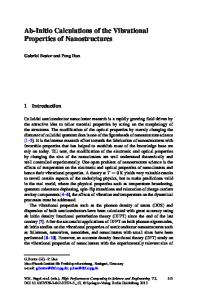Bonding and Vibrational Properties of CO-adsorbed Copper
- PDF / 669,082 Bytes
- 9 Pages / 414.72 x 648 pts Page_size
- 14 Downloads / 322 Views
Accurate density functional calculations are performed to investigate the structure and vibrational dynamics of carbon monoxide adsorbed to the (100) surface of copper. The adsorbate and substrate are considered as a unified system, with atoms of each treated on an equal footing. Coupling between the two components is found to have a significant effect. In particular, frustrated translational motion mixes strongly with transverse phonons of the substrate to form a broad resonance. Direct computation of anharmonic coupling between the internal CO bond stretching mode and other adsorbate-weighted modes confirms the experimental conclusion that the transient CO-stretch response seen in recent pump-probe studies is an indirect probe of the transient dynamics of frustrated translations. In this light, the computed resonance between this mode and substrate phonons suggests a dephasing mechanism to account for the observed relaxation dynamics. Keywords: theory, density functional theory, pseudopotentials, molecule/surface interactions, carbon monoxide, copper, vibrational modes, dephasing, laser spectroscopy. I. INTRODUCTION Because of widespread applications, such as catalysis, epitaxial growth, corrosion protection, and chemical etching, the interaction of molecules with solid surfaces has been a problem of considerable interest to materials and surface scientists [1-3]. These systems are challenging to study because the union of a molecule and a surface produces a richer variety of properties than either component separately. One important consequence of molecular adsorption is the emergence of new, low-frequency vibrations associated with fluctuations of the adsorption bond. For the simplest case of a diatomic adsorbate, for example, the new vibrations are classified as bond stretching motion perpendicular to the surface, frustrated translational (or wagging) motion parallel to the surface, and frustrated rotational (or rocking) motion. These modes are of interest because of their instrumental role in many important processes on surfaces [4], including chemical reactivity of adsorbates, energy transport, surface diffusion, and desorption. A prototypical system in the study of adsorbed metal surfaces is carbon monoxide on copper. Two recent pump-probe laser experiments [5,6] investigate the role that the low-frequency vibrations play in energy transfer between a copper substrate and an overlayer of CO. Qualitatively, the experiments differ mainly in the choice of surface: one studies the (100) surface [5] and the other the (111) surface [6]. These studies measure the time-resolved vibrational response of the CO molecules to (sub)picosecond heating of the copper substrate. In particular, they monitor the transient response of the high-frequency, internal CO bond-stretching mode, and, by arguing that the substrate heating is not high enough in energy to directly probe this mode, they infer that the data actually are caused by anharmonic coupling of the CO stretch to the low-frequency modes, especially frustrated translat
Data Loading...










